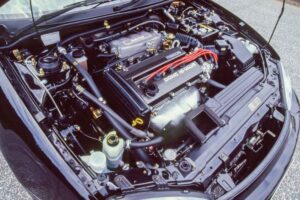Hidden long-selling model
The Autozam AZ-3 was introduced in 1991 as a sibling of the Eunos Presso. While the Presso targeted single men and women who valued their individuality, the AZ-3 was a model with a lighter, sportier flavour. What kind of car was the AZ-3, whose name is not heard as often today as that of the AZ-1?
Speciality coupe character
Autozam, one of the brands in Mazda’s five-channel system in the late 1980s and 1990s, operated as a dealership dealing mainly in minicars and small cars (although it also dealt in Lancias).
Among the Autozam brand’s models, there were several models with the name ‘AZ’, which symbolises Autozam, and no one would dispute that the best known of these is the AZ-1, a mid-ship mini-car model with gullwing doors.
The AZ-3 is the vehicle of the AZ series that existed in the shadow of the AZ-1.
The AZ-3, which went on sale in June 1991, was a stylish three-door hatchback coupe-style car with a number 5 body, and had the character of a speciality coupe rather than a sports car.
Although compact, it was also characterised by a rear window with a shape reminiscent of the RX-7, giving it a voluminous style. It is also important to note that an extra window was provided under the rear high-mounted stop lamps to ensure good rearward visibility.
The AZ-3 was the sibling of the Presso, which was released under the Eunos brand at the same time, and attracted attention as the world’s smallest (at the time) car with a 1.8-litre V6 engine, while the AZ-3 was differentiated by being available only with a standard 1.5-litre in-line 4-cylinder engine. The AZ-3 was differentiated by having only a standard 1.5L in-line four-cylinder engine.
But the differentiation only lasted for the first half of the model life, and with the addition of a V6 engine grade to the AZ-3 at the time of the minor change in September 1993 (conversely, a straight-4 engine was added to the Presso), the differences between the two cars, including emblems, were minimal.
At the time, the demand for compact coupes in Japan was cooling down, and unfortunately, it could not be said to have been a success in terms of sales, but it was a hidden long-seller model that continued to be sold until 1998.
It is also said to have sold well outside Japan, especially in Europe, where it was sold under the MX-3 name, limited edition models were released, and owners’ clubs still operate today.
translated by DeepL









































